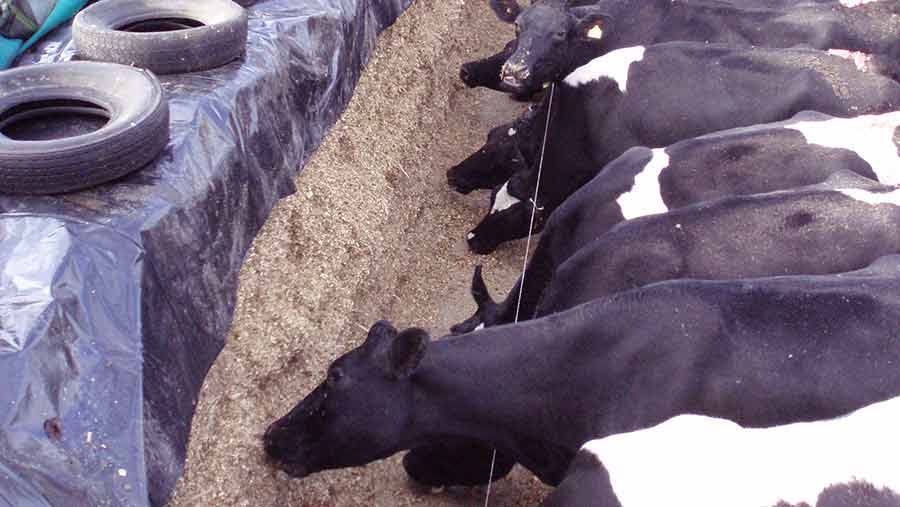10 tips for switching to self-feed silage
Self-feed silage is a simple and low-cost feeding system, but getting it right depends on adhering to some basic management principles.
Independent ruminant consultant Luppo Diepenbroek and self-feed specialist Kay Carslaw give 10 top tips on how to do it.

© Kay Carslaw
1. Ensure sufficient clamp space
Self-feed clamp measurements
- Locate 3-4m from the building when the clamp is first opened.
- 2m height maximum.
- 22cm feed space a cow for grass silage.
- 17cm feed space a cow for maize silage (as cows are able to eat quicker)
- Feed rate/rate of wire movement – 15cm a day.
- The wire should be 50cm back from the face.
Cows need to be able to reach the silage, so clamps should be a maximum of 2m high.
This means if you have a 4m-high clamp, you will have to double clamp space. Work out the silage and space needed based on recommended measurements (see right).
2. Design the clamp right
Self-feed clamps need to be wide, but not deep, as cows feed from the longest side.
To avoid ramps self-feed clamps also need to be filled from “side to side” rather than from “end to end” as with conventional clamps.
3. Locate clamps in the right place
Ideally the feed side of the clamp should face north-east so rain does not affect the face and reduce palatability. Use a stiff black plastic sheet on the top of the clamp and ensure it overhangs by 15-30cm. This will direct water away from the clamp.
See also: Self-feed silage helps lower dairy costs
4. Consider roofing the clamp
Roofing over the silage clamp is recommendable in the long term, but not essential. Roofing cuts the amount of rain landing on the concrete where cattle walk. This water is classed as dirty water and will need to be managed accordingly.
5. Think about space management
As cows eat into the clamp, the area needed for scraping can be substantial. Think about fencing off areas with metal drums and wires to reduce the area that need to be scraped.
6. Consider long-term payback
The concrete needed for new clamps is a substantial outlay, so this investment may not be worth it for farmers on short-term farm business tenancies.
For example, for a 2,100cu m silage clamp for 300 cows, with 15cm-deep concrete at a cost of £90/cu m, the capital investment on the floor alone will be £28,350 (excluding walls).
7. Get the wire placement right
The wire needs to be 50cm back from the face. You want cows to feed over the wire – the top 1.2m of the clamp should be eaten over the wire, and the bottom 80cm underneath. Some silage will fall down, but cows can eat this under the wire on the clean concrete.
Moving the wire closer so cows eat more is counterproductive as concrete and silage become dirty.
Wire voltage should be on the lowest power setting. Use a pony paddock fencer. A grounding wire can also be used so voltage strength is not excessive.
8. Train heifers from a young age
Eating over a wire goes against what cows are used to doing out in the field, so training heifers from a young age is well worth it.
Design a mini-clamp that still provides 15cm a heifer, but is lower at 1.2m high. Avoid silage ramps as heifers will walk over the wire. Bales can be used to square it up. The wire may need to be lowered slightly when training.
9. Don’t cut too dry
All forages can be self-fed. The easiest way is to layer different crops in one clamp, but different individual clamps can be fed, with cows shown to self-regulate intakes.
Grass with 28-30% dry matter or maize silage is ideal as the large, open face means it is open to air penetration and drier silages will heat up.
10. Adhere to best-practice clamp management
Best-practice clamp management at harvest is even more important to avoid wastage and maintain palatability.
Roll well, use cling film to keep air off the top and a heavy-gauge black sheet. Then uses a net and sand bags up to the edges.
